This presentation sets out some of the basic principles of the Business Entities ontology as it currently stands (as at Augist 31 2012; this contains changes to the May 2012 draft and June 2012 convenience document content).
You can download this as a PowerPoint presentation or as a PDF file here. Explanatory notes are included as slide notes in the PowerPoint version.
See Table of Terms section for recent changes to the current model.
Notes for the current series of business subject matter (SME) reviews are to be maintained here (October/November 2012).
We also maintain a rolling log of observations made during and between SME Review calls. Here is the latest iteration of this. All observations are recorded, and some initial responses are also given in the spreadsheet.
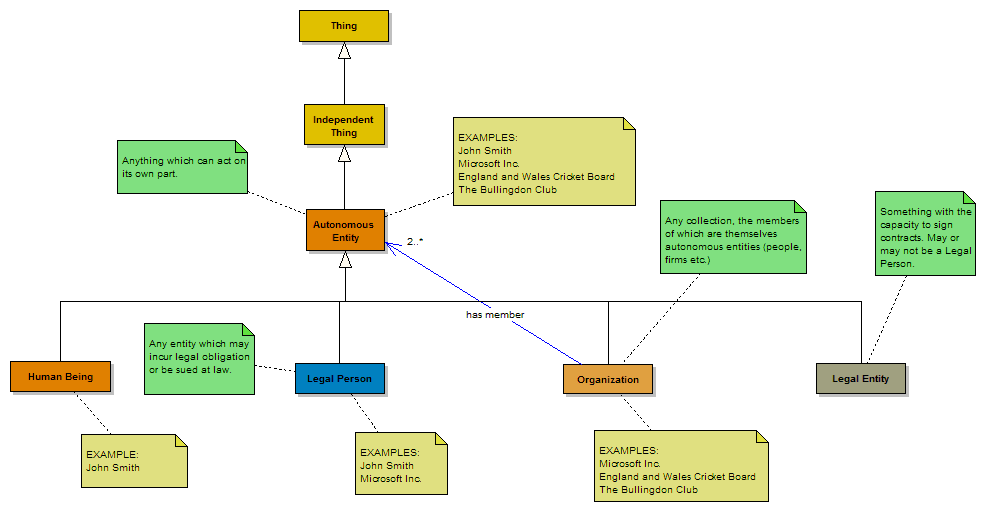
There are four basic types of entity in the FIBO Business Entities model. These are:
These are each defined as sub-types of a more general concept, that of "Autonomous Entity". This is any entity which can act on its own part.
Many of the entities which we are interested in may be both an organization and a legal person for example a limited company or corporation is both. Some organizations are not legal persons (e.g. partnerships), and some legal persons are not organizations (e.g. people). Also people are not legal persons if they have not attained the age of majority in their jurisdiction or if they are not considered to have the capacity to incur liabilities for some other reason. Note also that not all organizations are formal organizations.
The examples give an indication of the kinds of entity which may fall under one or other (or several) of these categories.
A semantic model (ontology) starts with a classification hierarchy i.e. a set of categories. The next few pages show those categories and what defines their membership.
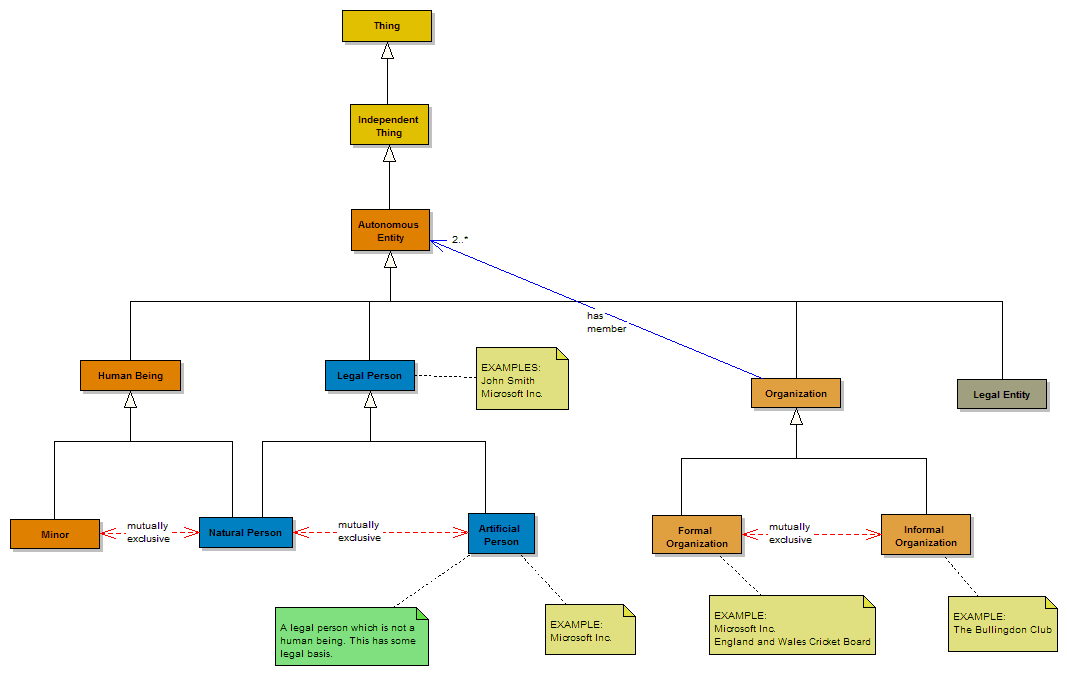
Extending this view further, Organization may be a formal or an informal organization. Formal organizations have some legal arrangements among the principals (e.g. a partnership agreement), whereas informal organizations do not. Informal organizations may be of interest in some money laundering business applciations.
Meanwhile:
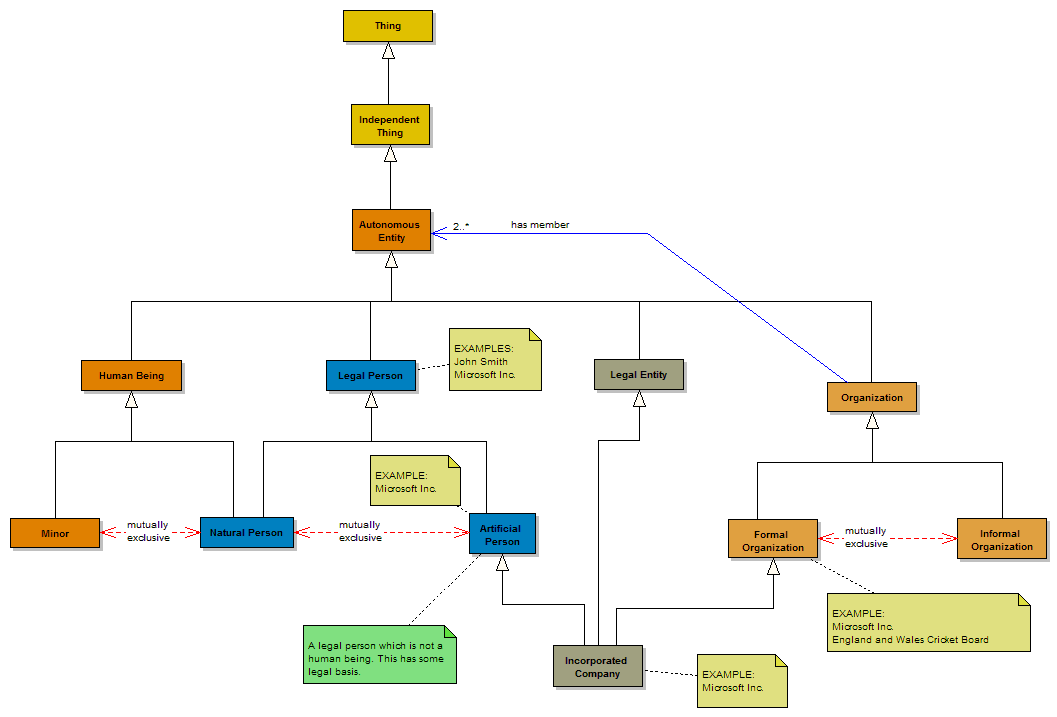
Incorporated Companies: here we start to use multiple inheritance in the model, to indicate things which are at one and the same time a legal person, a formal organization and a legal entity. Most business entities which are of interest will be all of these things (some, like trusts and non-incorporated partnerships, will be just one or two of these things).
The type of entity shown here is the Incorporated Company that is the limited liability company formed by the issue of shares.
Other Legal Person types, such as legally incorporated partnerships, are modeled in the same way i.e. they are both legal persons and formal organizations.
The examples given in the previous diagrams (in the yellow notes) are now allocated to the narrower categories into which they fall.
The next few pages look at the formal facts that we have considered as giving rise to these concepts.
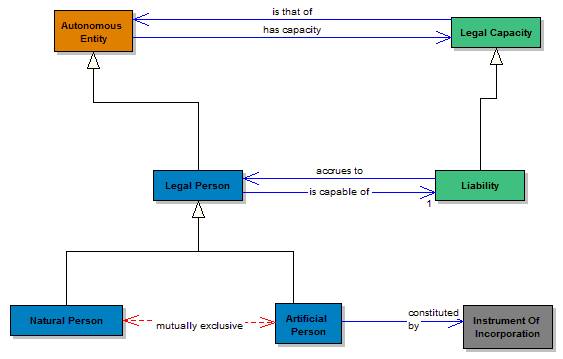
To be a legal person is to have the capacity to incur liability (including for example debt).
This is a well understood legal concept which defines what is a full legal person and what is not.
In order to be a legal person without having been born a human being, an entity generally has to be constituted in some jurisdiction according to some body of statute which exists in that jurisdiction. The means by which this is done is by the formation of some kind of instrument, such as (for limited companies) the Memorandum and Articles of Association (or whatever it is called in that jurisdiction). This is shown as a property of Artificial Person in the above. Each kind of Artificial Person (non natural legal person) must have some such instrument, but the names for them will vary according to the legal person type, as well as having different names in different jurisdictions.
A more nuanced legal view would define a wider range of kinds of entity according to the various legal capacities accorded to them (the ability to be signaturies to legal documents; the possession of rights and so on).

As for Legal Person, the concept of Legal Entity is here shown with its main defining fact. A Legal Entity is defined as something which is able to enter into contracts. Most such entities are also Legal Persons. The Legal Entity is that which is able to take on a contractual liability in the first instance, whether or not it is also the entity which is capable of that liability. When a party seeks redress, the Legal Entity is the first point they come to, even if the liability eventually turns out to be elsewhere.
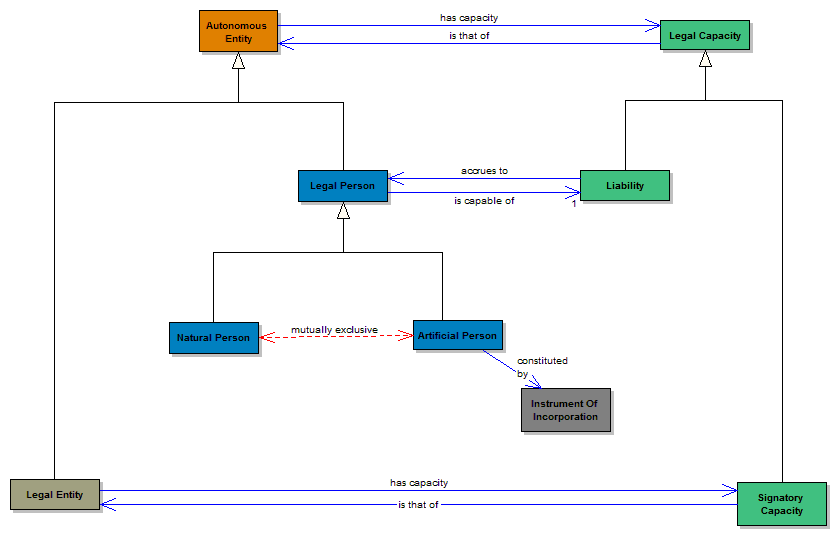
This diagram shows Legal Person and Legal Entity side by side. Each is defined by a distinct but different legal capacity. Legal Persons are further classified into Natural Person (a human being with legal capacity) and Artificial Person (a Legal Person which is not a human being). A similar refinement to the model may be desirable for Legal Entity. Alternatively, since the LEI scope is intended to exclude natural persons, this can simply be defined as being mutually exclusive with Human Being, thereby defining an entity which not only has signatory capacity, but is not a natural person. These questions will be the subject of further investigation and modeling.
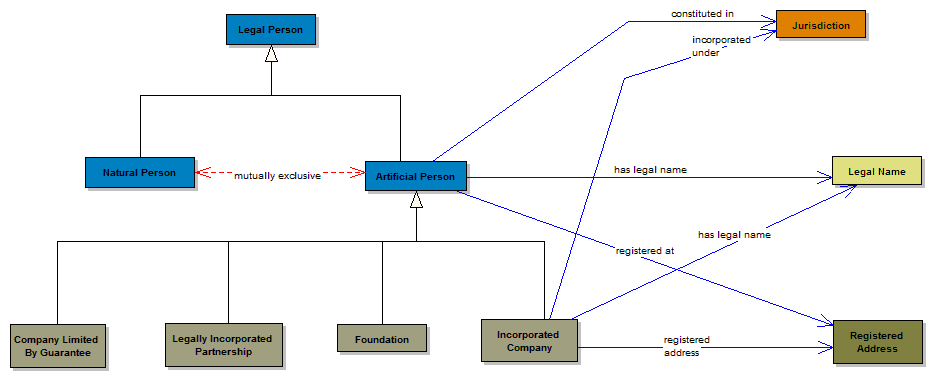
Building on the previous slides, we can now define the full range of types of "Legal Person" which are of interest. This diagram shows the main types of legal persons in the model. Note that these are entities with some legal form, registered in some jurisdiction (NB not country), and with formally required properties of legal name and registered address. Future review is needed to refine these necessary properties, e.t. it is possible in some jurisdictions (Belgium, Canada) for such an entity to have more than one legal name.
These are shown with the coloring used for Legal Entity, since these are also Legal Entities and the latter is possibly of more relevance in the model overall.
Note that this does not include Trusts or non-incorporated Partnerships since these are not Legal Persons in this sense.
The above categories are the "Buckets" into which each of the kinds of entity that may exist in different jurisdictions, may fall. The names of these will vary according to jurisdiction and language, but the basic mechanisms by which a legal person may be brought into existence in some jurisdiction that is, the mechanisms by which other entities may isolate themselves from liability are relatively limited.
We have referred to the World Bank report titled "The Puppet Masters" (a report about money laundering practices), in order to define the scope of the kinds of legal person we are interested in defining for this model.
In creating a kind of vehicle which carries its own liability (and so isolates its principals from liability in their own right), there are a number of specific mechanisms which now exist:
The term "Foundation" may require further elaboration since different jurisdictions have different and very specific arrangements by which Foundations may be founded. Further research is needed into whether they are in fact Legal Persons, or just Legal Entities. This too may differ across jurisdictions. Of particular interest to the WB are the kinds of Foundation which may be created in the jurisdictions of Panama and of Luxembourg, each of which has particular arrangements unique to the jurisdiction.
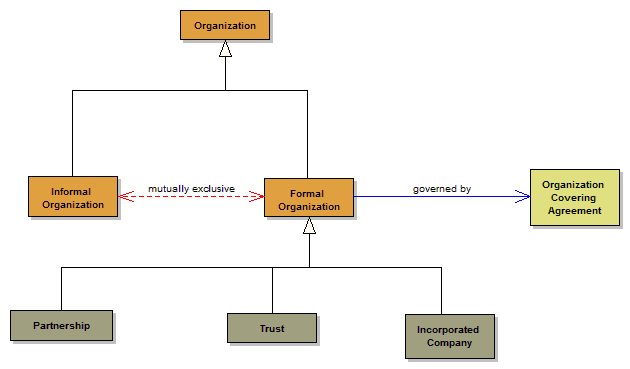
The previous pages showed the arrangements by which some organization may be constituted as a Legal Person. Separately from this, there is the concept of Organization itself. This is something which is made up of parts, which are themselves autonomous entities. Typically the units of which an organization is made up are people. They may also be separate artificial persons (such as companies in a group).
A Formal Organization is defined by the existence of some formal contractual agreement among its principals, identified here as the "Organization Covering Agreement". An organization which does not have such an agreement is not a formal organization. For some entity types, e.g. Trust, some partnership forms, this agreement takes a relatively standard form. This agreement does not give the organization legal standing as a Legal Person in its own right (that is the role of the instrument of incorporation, as already shown).
Most of these are aso Legal Entities and so are shown in the color for that type of entity.
We are particularly interested in the kinds of organizations which may enter into transactions or other formal business relationships (these may or may not also be businesses that is a separate part of the model not shown here). These are identified as "Formal Organization"
We introduced the concept of "Formal Organization" into the model simply to distinguish it from organizations more generally (we try to define each concept in the model by specializing the most general concepts that may exist so Organization may be any entity that consists of other entities, in the wider world). Having done so, the business SME reviewers recognized the value in being able to talk about informal organizations as well, for example in the context of money laundering where a group of informally associated individuals (such as a crime syndicate) might hold a significant number of shares among them. Therefore Informal Organization is also included in the model.
Limited companies also typically have a "Directors Agreement" among the directors, which is distinct from the Memorandum and Articles by which the entity is formed. So entities which are both a legal person and a formal organization, should be seen to have both.
Organizations may also be organized in distinct parts or structures, such as branches, divisions and so on.
Note that this is distinct from a subsidiary: the formal definition of a subsidiary relates one limited company to another via the ownership of shares, so that is a relationship between organizations not within one. However a "Group" (such as Shell or Barclays) may be defined as an organization whose parts are limited companies.
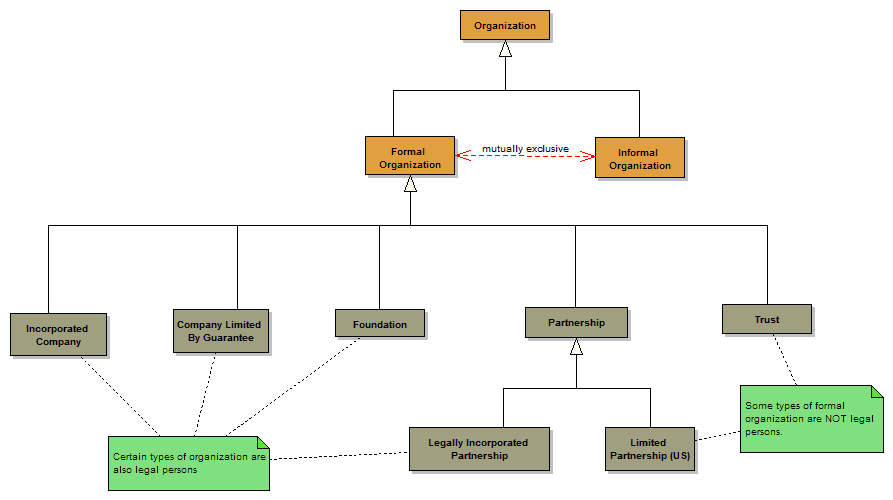
From the above models of Legal Person, Legal Entity and Formal Organization, we can now define the complete hierarchy of Formal Organization. This is the kind of entity which may be of interest for this model (i.e. the kinds of entities which may be a business, which may buy, sell or hold securities, and so on).
These are the types of Formal Organization which exist in the model. These are also Legal Entities.
Legally Incorporated Partnership is both a Partnership and a Legal Person, while some forms of partnership are not strictly legal persons (they are however Legal Entity under the new term for these).
It may prove, on further review, that the nature and scope of LEI is satisfied by the concept of Formal Organization. At present, these two types of entity are kept distinct - one defined by having a formal contract among its principals, the other defined by its ability to sign contracts. This is to enable detailed discussion of these two distinct concepts, whether or not they can later be usefully be amalgamated into a single concept which possesses both properties.
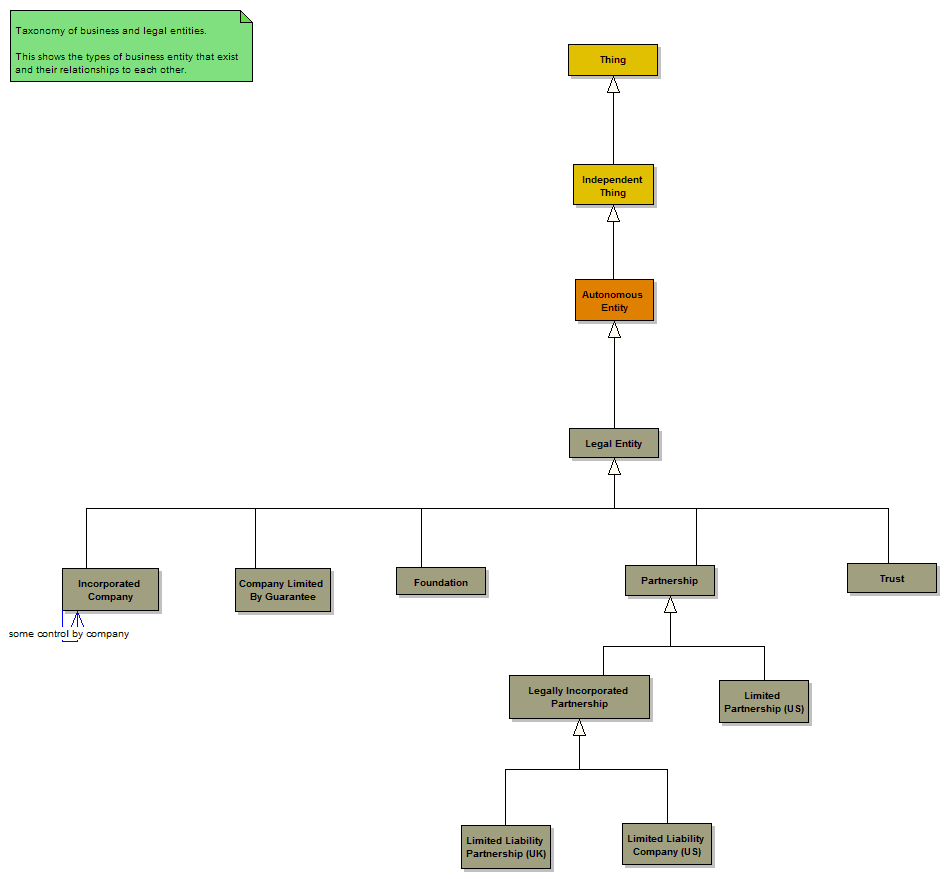
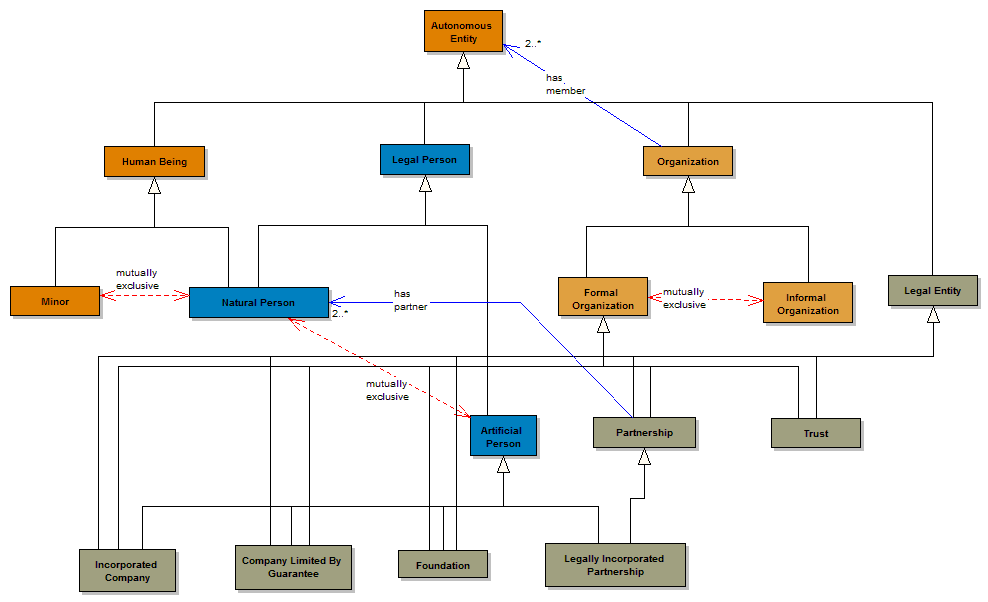
We can now define the complete hierarchy of items of interest for this model i.e. the kinds of entities which may be business, which may buy, sell or hold securities, and so on.
This diagram shows all all the main concepts, and how most of the entities which are of interest are classified as all three of Artificial Person, Formal Organization and Legal Entity, with the exception of Trusts and Partnerships, these being Formal Organizations and Legal Entities but not Legal Persons.
This is a multi-faceted hierarchy, showing the categories into which each kind of entity may be classified. Note that the bulk of the items which are of interest (e.g. limited companies) are categories which sit in more than one hierarchy. Some of these are legal persons in their own right. Most are kinds of Formal Organization. All those entity types which are of interest are Legal Entities also.
For a practical application, one would want to extract one or other of these hierarchies, depending on the primary focus of the application requirement (use case). For example, is one interested in organizations, or in legal persons?
Virtually all of the entities of interest are non natural legal persons. However, if one were extracting terms for a loan-related application, then human beings would also be of interest, and one would use the Legal Persons hierarchy (since you cant lend to a minor or other human which does not have legal capacity). Conversely, if one were extracting a hierarchy of possible contract counterparties or securities holders, these are distinguished by their ability to be a party to a contract, and so the Legal Entity hierarchy would be extracted.
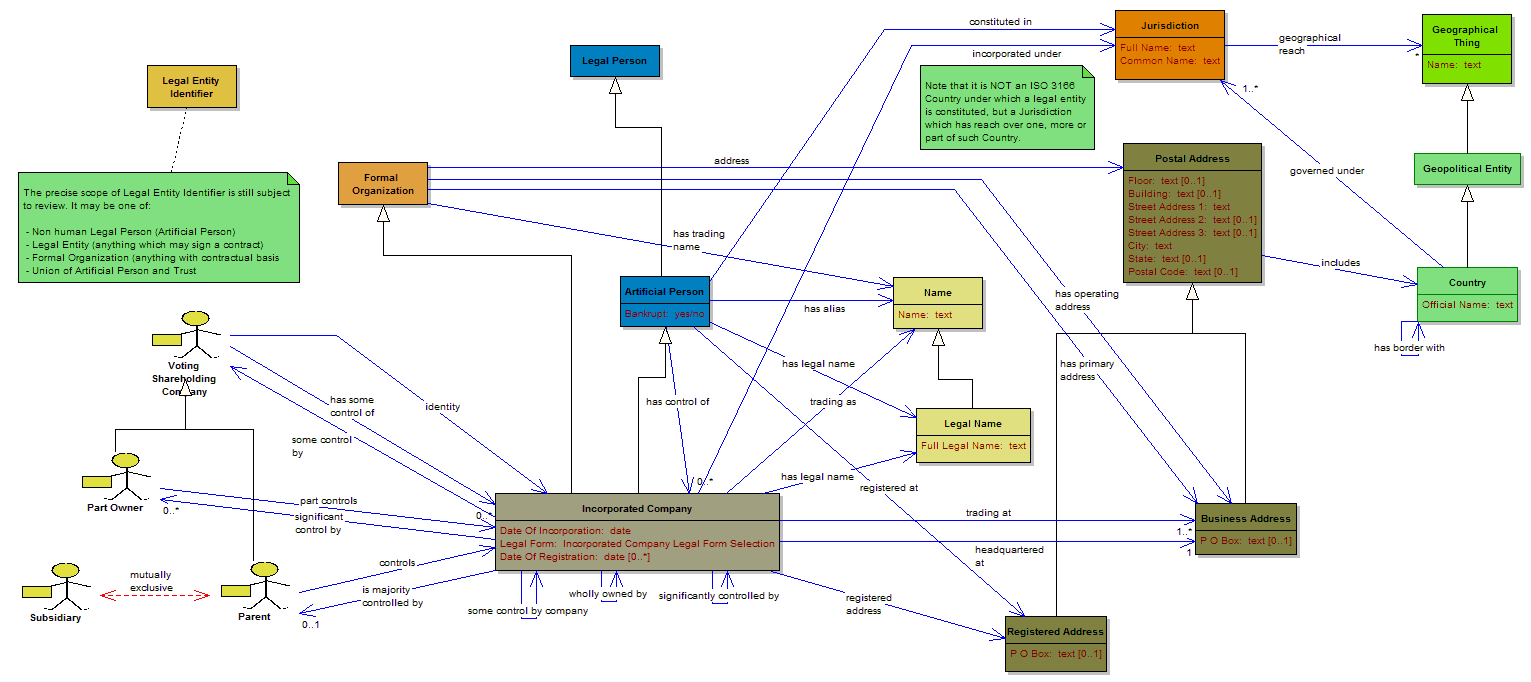
Having defined the kinds of entity which may exist, we focus on the Incorporated Company, that is the company founded by the issuance of shares.
These are always constituted in some jurisdiction, that being the jurisdiction under whose body of statute law the provisions for founding such a company exist. Note that this is NOT a country. Entities may also have a "domiciled in" property which relates to the country in which their address is located, but the formation of the company relates to a jurisdiction not a country.
Jurisdictions often have a one on one relationship with countries. Where they do not is in federations like the USA, Canada, Australia etc. (where each State, Province or Territory has its own legal jurisdiction), and in historically unusual countries such as the United Kingdom, where the principal jurisdictions are "England and Wales", and "Scotland". This is reflected in the way that the Registration Code is required to be cited on formal correspondence, for example "Registered in England and Wales number 2461068".
At the constituting of such an entity, the jurisdiction under which it is constituted generally makes certain stipulations. For example, the new entity must have a formal "Registered Address" which is to be shown on all correspondence; it gets given a Registration Number under that jurisdiction, and so on.
As a minimum we usually have:
Note that the registered address may or may not be the same as the regular address at which the entity does business. More usually it is the address of an accountant or lawyer. Even if this is the same address, the meaning of the address is different (it is the place where legal papers may be served on the entity, as distinct from the address where you may write to them or the address where you may buy their products).
NOTE: The "Address" concepts here are place-holders, as we intended to find some suitable global standard for addresses. Future drafts will include an updated address ontology.
Also shown on this diagram are some basic ownership and control relationship hierarchies. These are explained in the next part of this presentation.
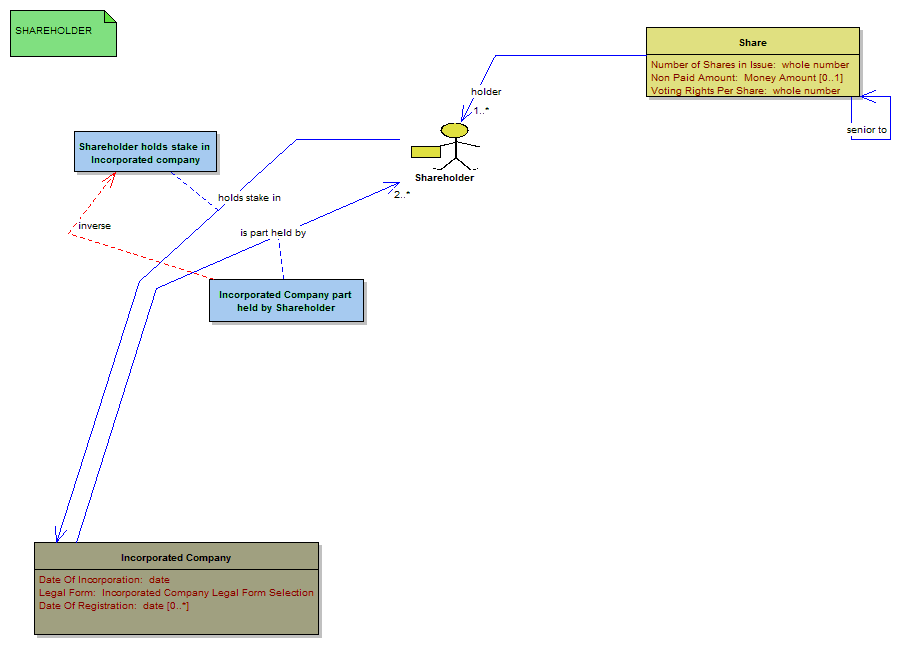
We start with the basic building block of all of these kinds of relationship: the owning of some share in some Incorporated Company.
Note that such shares may only be owned in an Incorporated Company.
At this point, this may be any kind of share (with or without voting rights).
Note the stick man icon: this represents what we call a "Party". A Party in this sense is some entity standing in some role. This is a "Relative" concept, i.e. its definition is that of the "entity in a role" and not of the entity itself. All "Party" concepts have some "identity" property which identifies what sort of independent entity may fulfil the role which is defined for that party. All parties have a relationship to whatever it is that they are party to.
In this case, the party is a Shareholder, and the definition of the Shareholder is that is the holding party in relation to some Share, and that it is some party which the company is part held by. An inverse relationship is also shown for "part held by", namely "holds stake in". The "identity" relationship is not shown in this diagram, but may be any kind of autonomous entity (for simplicity in fact this may be a human or a Legal Entity, but not for example a fish).
Note for modelers: this term "Party" is closer to the usage of the word Party in natural language and legal terms, e.g. "The Party of the First Part", or "Being party to some arrangement". This is completely different to the terms which are labeled "Party" in some other semantic models such as FOAF. All terms in FIBO are defined with reference to accepted legal usage, not with reference to technical usages that have not been grounded in language or law.
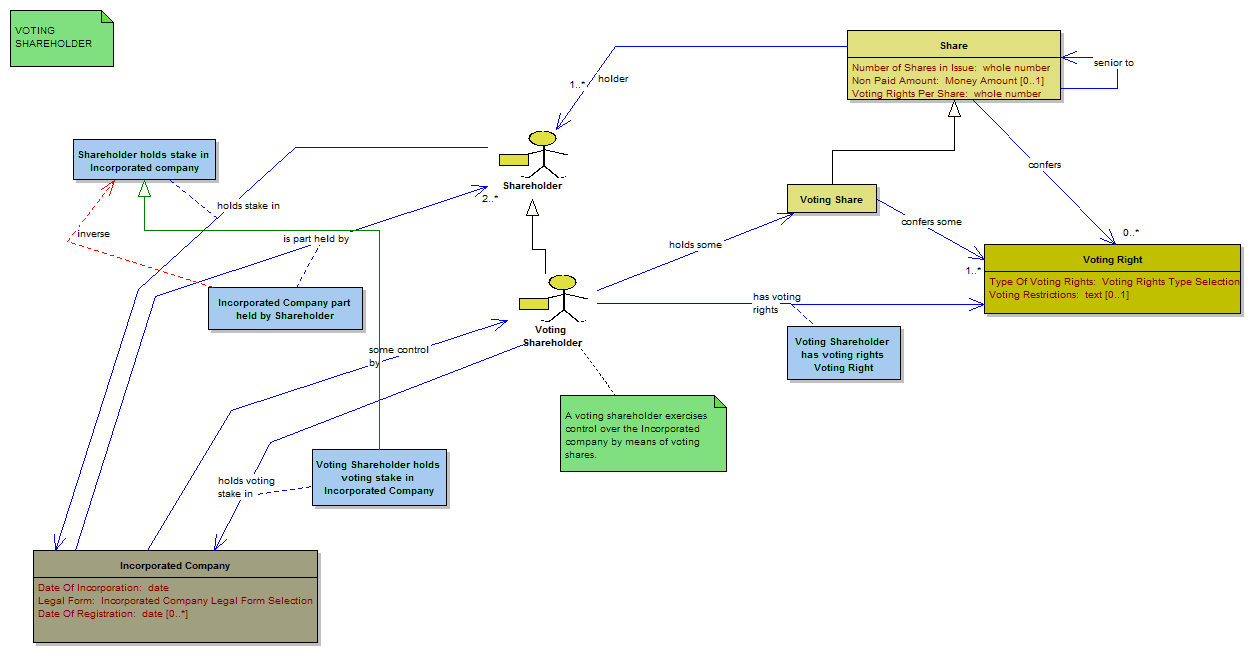
From the above terms for Shareholder and Share, we now specialize this to the kind of share that gives some degree of control to the holding party: the voting share and voting shareholder.
Note that where shares (like any contract) give a party certain rights, the Voting Share gives the holding party some Voting Rights.
There are other mechanisms for control (modeled elsewhere in the model), but this is the form of owning and controlling relationship which is the basis for all relationships of the type "Part Owner", "Parent", Subsidiary" and so on.

In order to define the relationships of interest here parent, part owner, subsidiary etc., the party which is the Voting Shareholder must also itself be a Limited Company. This is shown by the "identity" relationship which defines the meaning of "Voting Shareholding Company".
All of the relationships of interest in this part of the model are specializations of this relationship, and all the parties which are identified as Parent, Part Owner, and the corresponding inverses of Subsidiary etc., will be derived from this set of terms.
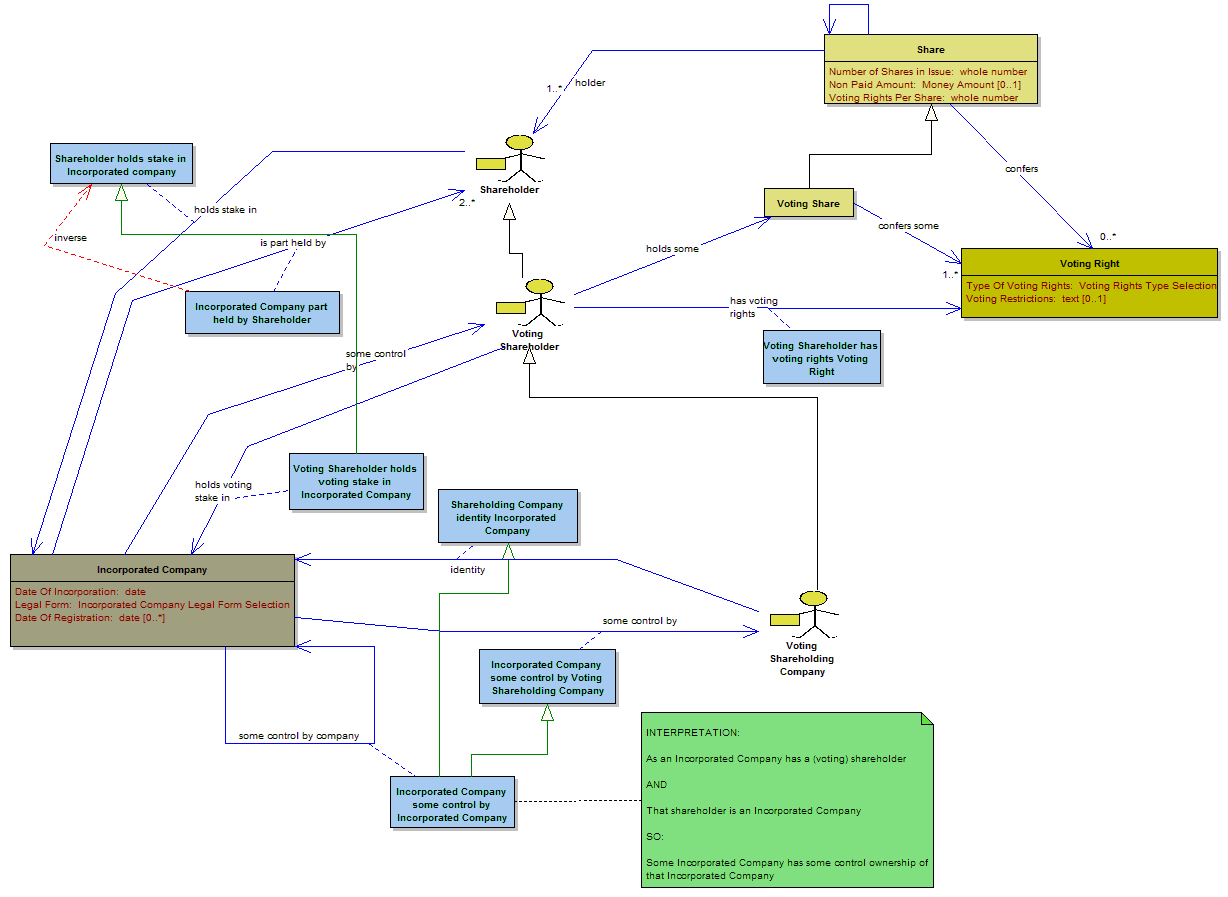
From the relationship in the previous diagram, we have added a new relationship. This is the direct relationship between one Incorporated Company and another. This term gets is meaning from the combination of the relationship to the party, and the identity of that party.
OWL Modelers: in creating operational ontologies, one can ignore the relative "Party" term, for which there may not be instance data, and simply adopt the model of the Incorporated Company with its self-referntial relationship.
This is a relatively new addition, and has not yet been done for all these party-based relationships. This will become a feature in future releases.
The next few diagrams show the same arrangement, as applied to types of party which are derived from Voting Shareholding Company.
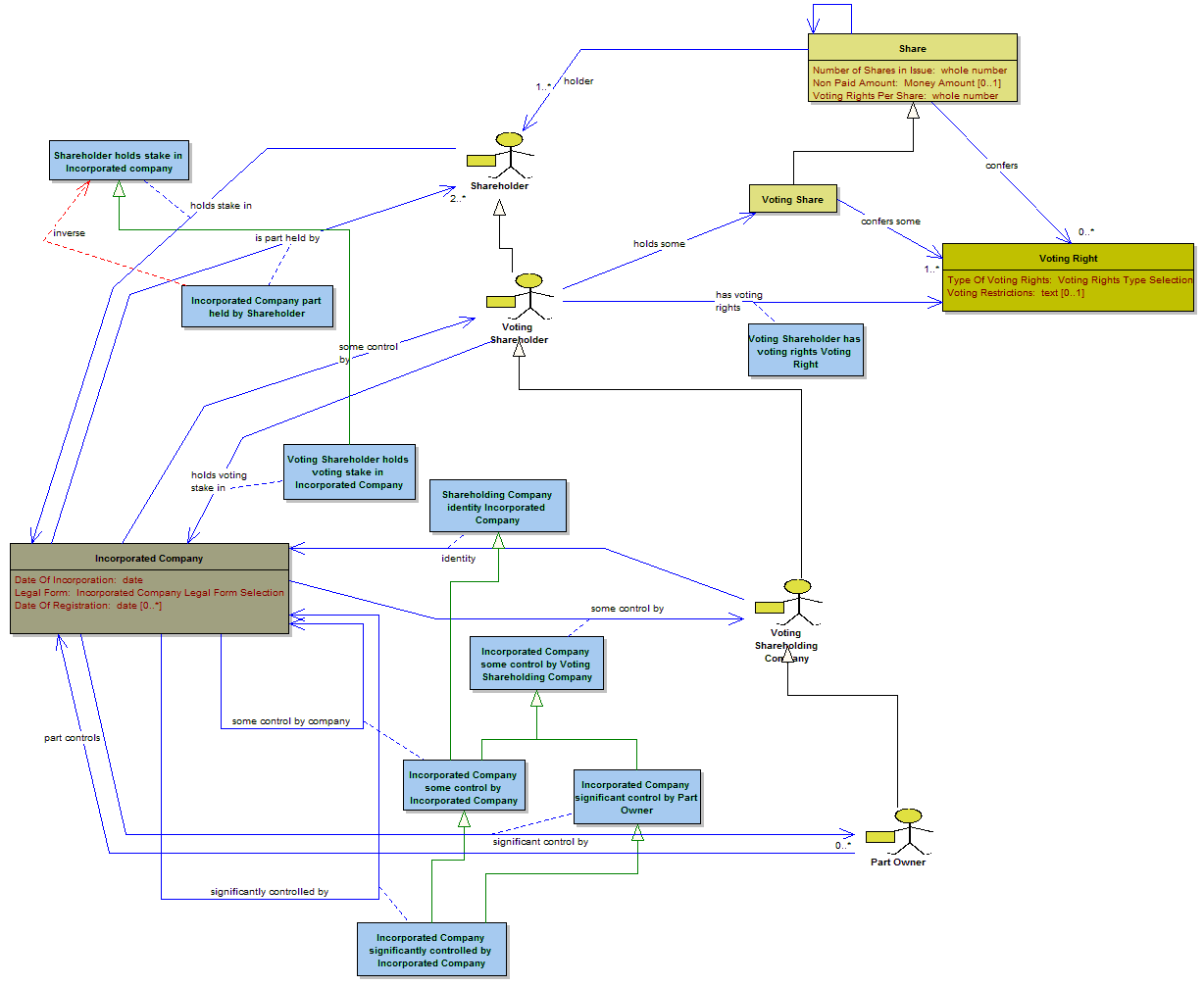
From the Voting Shareholding Company party and its relationship to the company, the first relationship we derive from this is Part Owner.
There are several possible meanings we could have given to the term "Part Owner". Here, it is defined as something which has ownership between some minimum and some maximum, such that the term "Parent" is not a sub-class of this.
The thresholds are not modeled at this point in time, these are simply stated in the written definition.
OWL Modelers note: Note that the direct relationship between Incorporated Company and Incorporated Company, which may be used in operational ontologies, is given as a sub-property of the "some control by" property.
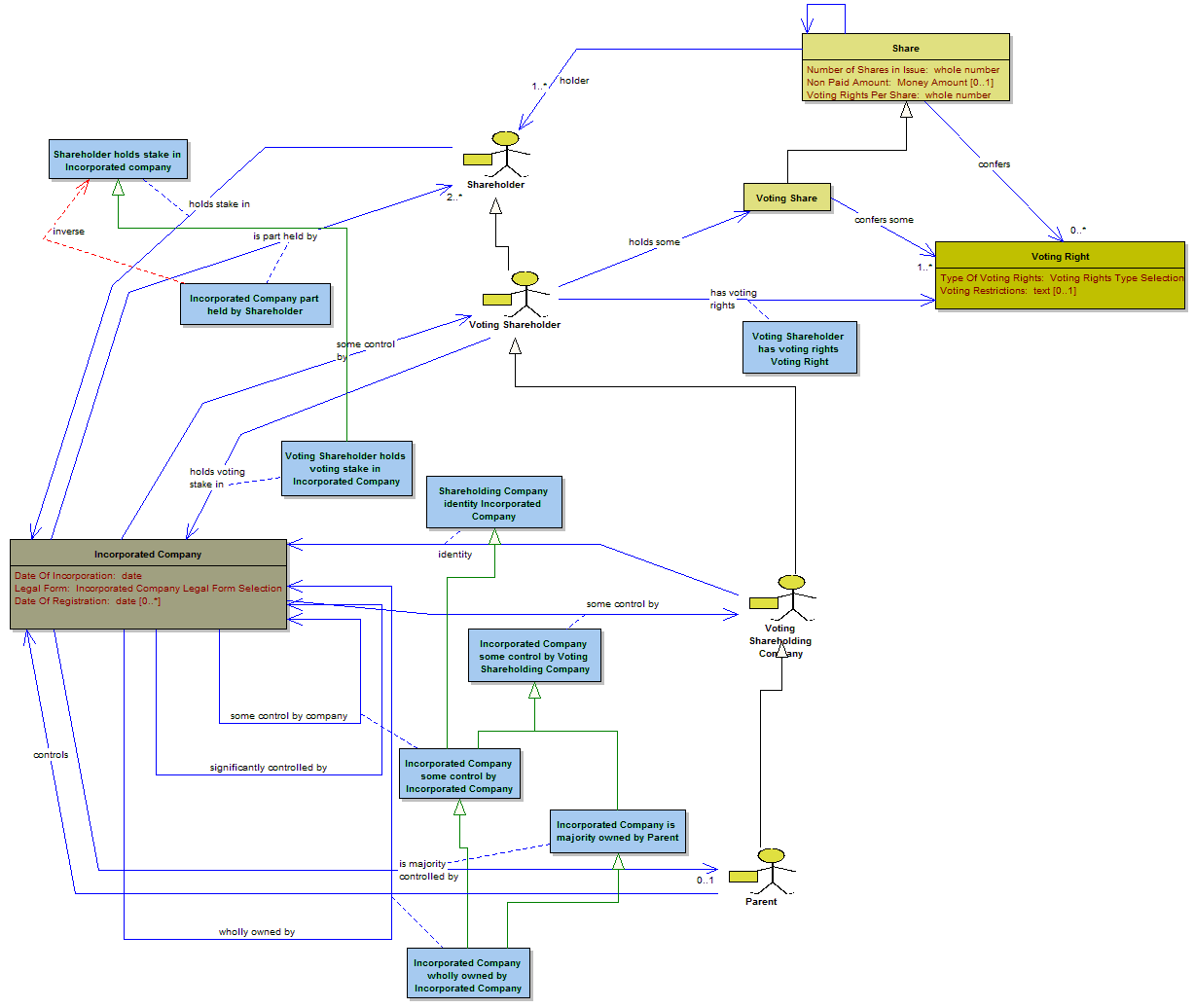
The relationship of "Parent" is given according to the conventional definition of some party which has 50% +1 share ownership (in voting shares).
LEI Note: for LEI purposes, there may be different thresholds which are considered of interest, and for which a similar label of "Parent" is given. To dismbiguate this, we will use the term "Deemed Parent" and the corresponding "Deemed Subsidiary". These are not shown in these slides but are in the model. Note that for Deemed Parent, there is in addition a property which is the threshold of ownership for which one wishes to deem that entity a Parent or Subsidiary (for example 25%).
OWL Modelers: Note again that the direct relationship between Incorporated Company is a sub-property of the "some control by" relationship.
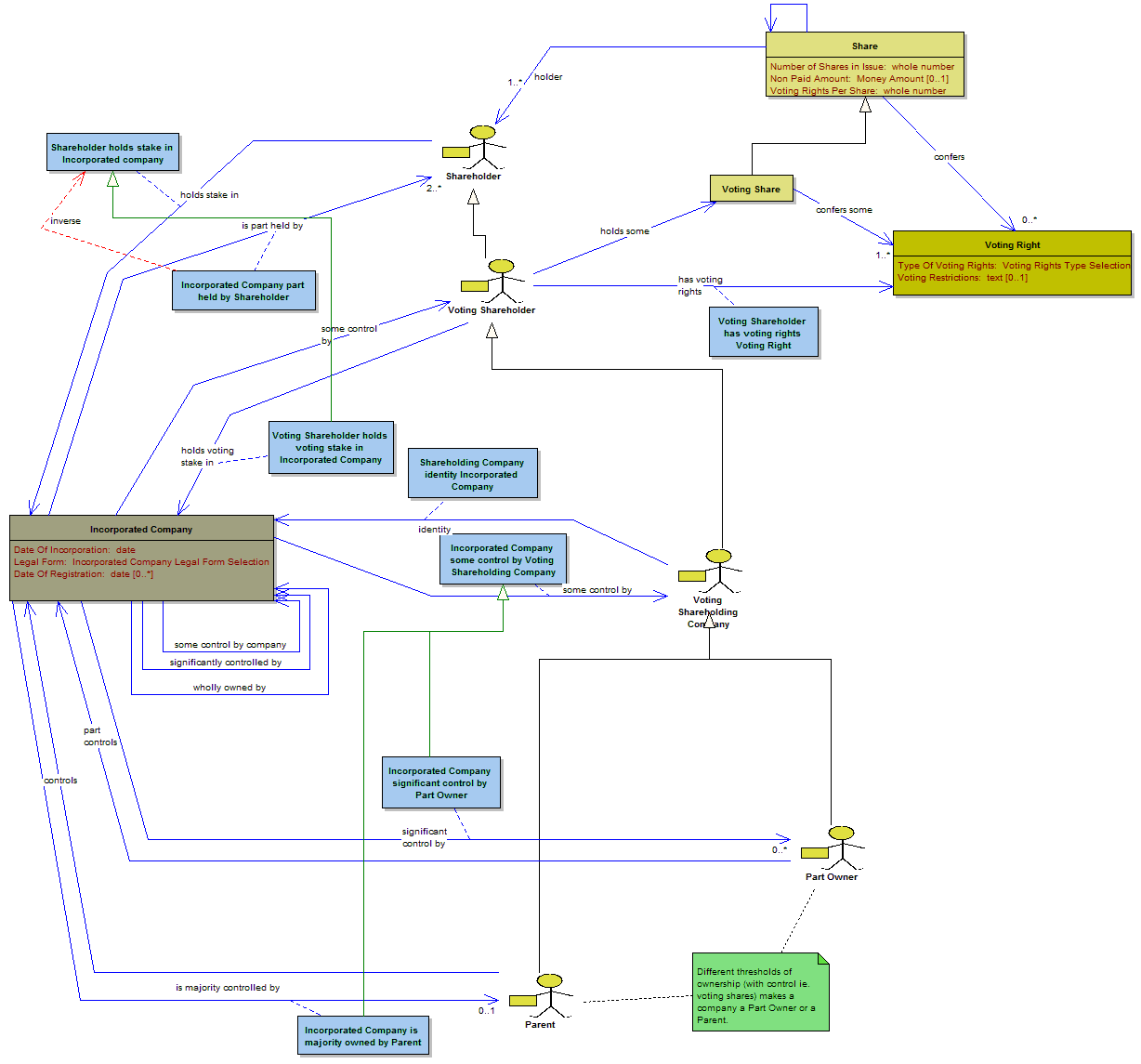
Finally, the relationships developed in the preceding slides may be seen in one view. This shows Part Owner and Parent side by side (as defined here, Part Owner is not simply "any" part ownership thats in "Voting Shareholding Company"; rather, its some entity which owns some stake above some minimum but below 50%).
Note that each relationship from the Incorporated Company to the Party, has a corresponding inverse relationship going the other way. This is a feature of RDF/OWL models all relationships are in one direction only, but may be in pairs.
UML Modelers: if you were to translate this into a UML model, these pairs of relationships where one is the inverse of the other, would be modeled as a single "Association" relationship, where the labels and definitions of the two relationships here, would be the labels and definitions of the association ends.
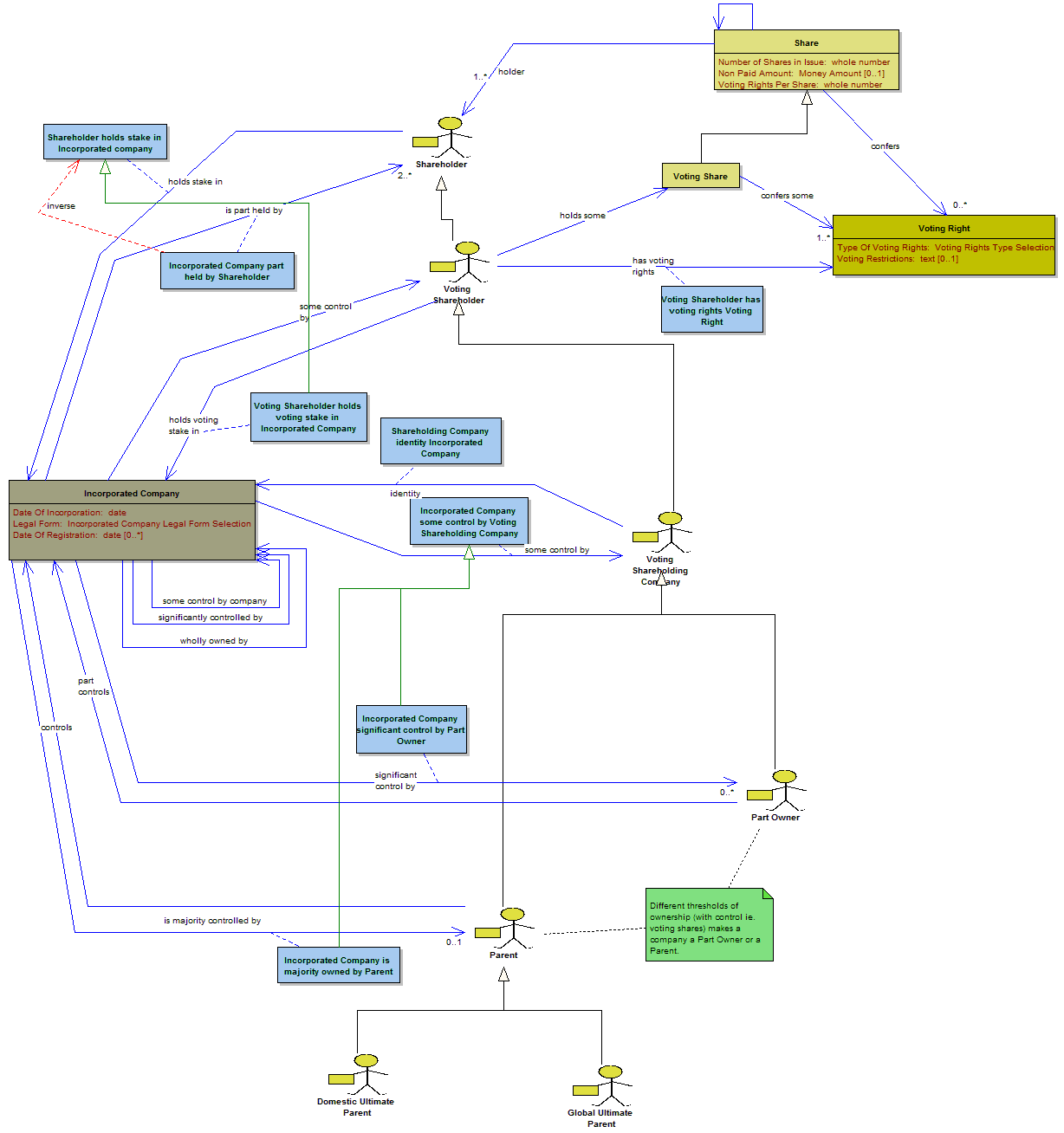
Based on terms in DTCC and elsewhere, there are two kinds of "Ultimate Parent" which any given corporation might have. These are the domestic Ultimate Parent and the Global Ultimate Parent.
These are both simply shown as sub-classes of Parent. We have not modeled any formal facts which make something the domestic and/or global ultimate parent. In most data models, these terms will exist, as companies which fulfil those roles.
What we have shown above is the basic development of the relationships which are of most interest in the LEI initiative, namely relationships of ownership and control. Although these are usually thought of as being between "Legal Entities", in fact they exist only by virtue of the ownership of shares, by a company, and by definition shares can only be owned in something which is a limited company.
Where many data models have one set of relationships for ownership, there are in fact several kinds of ownership and control. It is possible to own shares in a company without control (non voting shares); it is possible to exercise control other than through share ownership, for example through some means of management control. Meanwhile, the kind of control which follows from the ownership of voting shares may or may not be exercised, and if it is exercised this effectively takes the form of being able to vote for the composition of the board.
During subject matter expert reviews, we exploded the minimal set of relationships seen in typical data models, into these different nuances of control, and of either one without the other. These all exist in the model but may not be included in the initial release of FIBO Business Entities, depending on what is considered useful to the industry.
An open question is what to call a relationship where shares in a limited company are owned by some kind of formal legal person that is not itself a limited company - for instance, is this still considered a "Parent"? There remains some work to do on these nuances, but at present as are only looking to model the most basic relationships (subject to confirmation from the business on what is considered relevant to them).
As noted previously, the LEI concept of "Parent" is based on (possibly) a 25% threshold and therefore differs from what is formally defined as Parent in the wider world. We have labeled this "Deemed Parent" for want of a better name (it is something which is deemed to be the parent by someone). The property which is the threshold where the deeming happens, is present in the model but is not visible on diagrams since these have the Party icon.